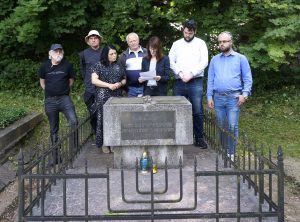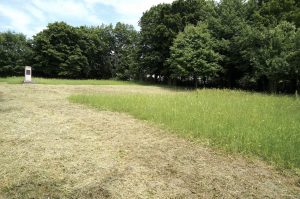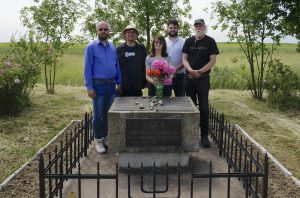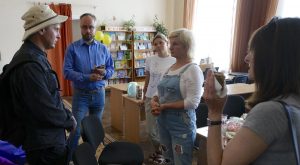Marking 80 years since the final liquidation of Rohatyn’s wartime Jewish ghetto, today Jay and I stood with friends before the memorial monument marking the north mass grave at the vodokanal to recite a prayer and remember history at the final resting place for more than 3000 Jewish Holocaust victims from Rohatyn and the surrounding region, including Burshtyn, Khodoriv, Bukachivtsi, and many other places.
![]() Ця сторінка також доступна українською.
Ця сторінка також доступна українською.

Gathered at the memorial monument for the victims of the ghetto liquidation and other killings. Photo © RJH.
We were joined by Lviv friends and colleagues Wito Nadaszkiewicz, heritage advocate and attorney for Rohatyn Jewish Heritage; Alex Dunai, lecturer and family researcher; and Joel Wasserman, an American journalist living in Ukraine; as well as Kyiv’s Taras Grytsiuk, one of four leaders of the German-Ukrainian “Connecting Memory” program; Tetiana Petriv, director of Rohatyn’s UNESCO-listed Holy Spirit Church and Museum of Prykarpattian Art; and Ihor Zalypko, engineer at Rohatyn’s vodokanal and who for the past several years has been helping us care for the Jewish burial sites in Rohatyn.
In the presence of these friends, I read the following speech on behalf of Rohatyn’s Jewish families who could not be here today:
Today we stand witness to the memory of the thousands of Jewish men, women, and children who were executed and buried together at this site north of town center, commonly known as the vodokanal. We are here to remember that 80 years ago today, the final liquidation of the Rohatyn Jewish ghetto began: a series of organized executions and burials at this site starting on June 6, 1943 and continuing for two to three days, taking the lives of several thousand Jews from the district. Jewish and Ukrainian memoirs say that smaller executions continued here afterward, killing captured survivors from earlier aktions, until the end of the war.
When the ghetto was liquidated 80 years ago, most of the Jewish individuals and families originally from Rohatyn – our families – had already been murdered the year before. Those still alive in the reduced ghetto space were mostly Jews forcibly brought to Rohatyn from surrounding towns and villages. They numbered more than three thousand. Some of these Jews anticipated the fate that awaited them and went into hiding in bunkers clandestinely built inside and outside the ghetto. Most did not succeed in eluding capture and were shot upon discovery. A small, unknown number resisted the liquidation with fortifications and weapons smuggled into the ghetto, too few to withstand the onslaught during those days. We know from Jewish and Ukrainian testimonies that ghetto inhabitants were marched to the vodokanal – the area where we stand today – and shot on planks laid over deep trenches, dug days before; there were only a few witnesses.
It is painful 80 years later to imagine the violence of those days. It is not difficult to understand that for many Jewish descendants of the Rohatyn area it is still too painful to come today to Rohatyn. We are immensely grateful that some Rohatyn Jewish survivors and descendants came to Rohatyn more than twenty years ago to erect this monument as a memorial to the lost, together with the city administration of Rohatyn, local historians and townspeople, and religious leaders of all faiths.
By our coming together today to pray, to reflect, and to honor the memory of the Jewish victims, we build bridges and work to ease cross-generational pain. By our presence here together, by our solidarity on this date, at this site, we send a message of tolerance and forgiveness, of remembrance and compassion.
On behalf of my Rohatyn families and Rohatyn Jewish descendants living abroad, I thank you for coming and joining me in remembering. May the memory of the victims bind us together. Baruch Dayan HaEmet.
Then we remained in silence as Joel recited the Hebrew prayer “El Malei Rachamim” (אֵל מָלֵא רַחֲמִים, “God, full of mercy”), with which we pray that the souls of the murdered innocents may rest protected in the Garden of Eden.
Despite this being a sad, solemn event, our spirits were lifted by the presence of our friends and by the seasonal flowering shrubs Ihor had recently planted at the memorial site, something he has been doing each of the last several years, in addition to mowing and light maintenance at both north and south Jewish mass graves. Beginning last year, Ihor has also been helping us out cutting and clearing at the old Jewish cemetery, a multi-day task at this large historic site that begins in late April and continues until late September or early October. We are very grateful for Ihor’s continued involvement and attention to detail, a role he assumed when our beloved friend and long-time local partner Mykhailo Vorobets z”l was no longer able to organize this work himself.
As part of our visit to Rohatyn today, we also met with other friends and residents in town including at the Rohatyn central library and in one of the former Jewish neighborhoods. We concluded the day visiting each of the Jewish burial sites to check and record their status and to place remembrance stones at the monuments erected 25 years ago. We are very happy to report that all of the burial sites are in good condition and well-maintained during this active growing season, a balm on an otherwise difficult anniversary. We know that other Jewish descendants of Rohatyn and district towns and villages have also marked the day for memory, either today or on the Hebrew calendar yahrzeit, and we felt together as a community still.

The new Jewish cemetery in Rohatyn today, in the midst of its second clearing this year. Photo © RJH.
May the memory of the Jewish victims of 80 years ago bind us together.
May peaceful skies return to Ukraine soon.
Baruch Dayan HaEmet.


